When most people consider bringing a goldfish home – even a fancy goldfish – they may not have aspirations of entering the show ring. But if you’re considering a Ranchu goldfish (Carassius auratus), the temptation may be too great.
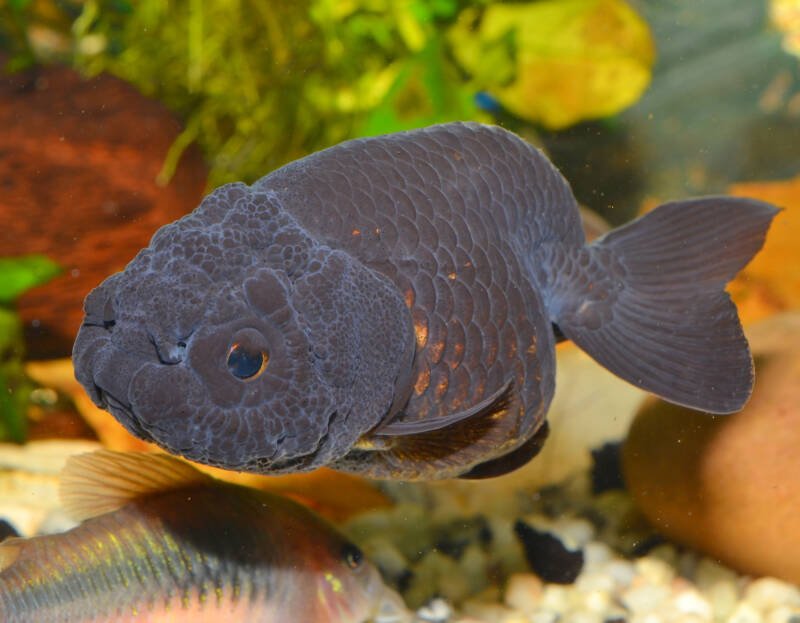
These stunning human-made varieties of goldfish aren’t the easiest to find. You probably won’t stumble across them in the average fish store. (And if you do, odds are they got mislabeled)
But if you aspire to own the “king of goldfish,“ they’re the breed for you.
And you’re in good company. Ranchus have a loyal following around the globe.
Bred to represent the best aspects of Japanese culture, they add a touch of harmony to any home that displays them. And, unless you plan to show your Ranchu, they’re undemanding.
However, this isn’t the simplest variety of goldfish to care for. Their unique body plan requires some forethought on your part.
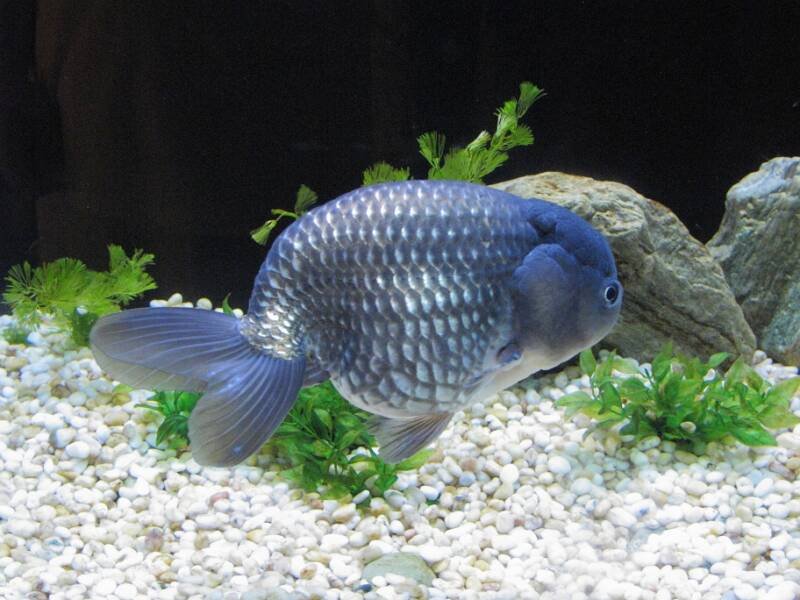
And you’ll have to stay on top of their pristine water needs if you want them to remain healthy. It’s challenging but not impossible.
At a Glance
| Tank Size: | 20 gallons (80 l) for one, 10 gallons (40 l) for each additional goldfish |
| School Size: | will tolerate being alone |
| Temperature: | 65-72°F (18-22°C) |
| Lifespan: | 8–15 years |
| Size: | 5-8 inches (13-20 cm) |
| pH: | 7.0-8.0 |
| Hardness: | 5-19 dH |
| Ammonia: | 0 ppm |
| Nitrite: | 0 ppm |
| Nitrate: | 0 ppm |
In this article
In the Wild
With their egg-shaped bodies, prominent heads, and hoods, Ranchu goldfish AREN’T designed for survival in the wild. And you won’t see them in rivers, lakes, or streams.
They’re a human-made goldfish breed that first appeared in the 17th century.
Marco Ranchus got their start in China. But when Dutch traders brought the fish to Japan, Kameyoshi Ishikawa I saw the potential in the breed.
He began to cultivate the Ranchus into the sumo-like fish people know them as today.
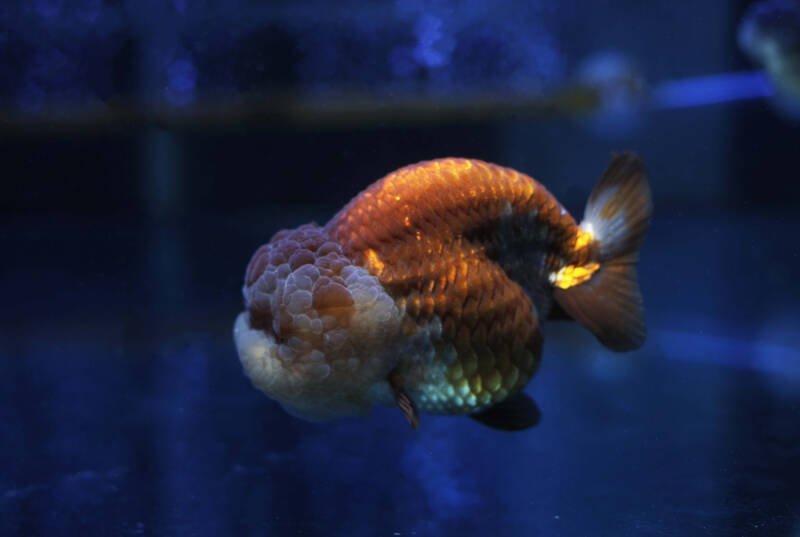
At that time, Ranchus took on their unique appearance. Shorter in the body than lionhead goldfish, they have a prominent smooth arch over their backs and no dorsal fin. The caudal peduncle’s bracelet (the base of the tail) tucks in. The double tail spreads out from the bracelet.
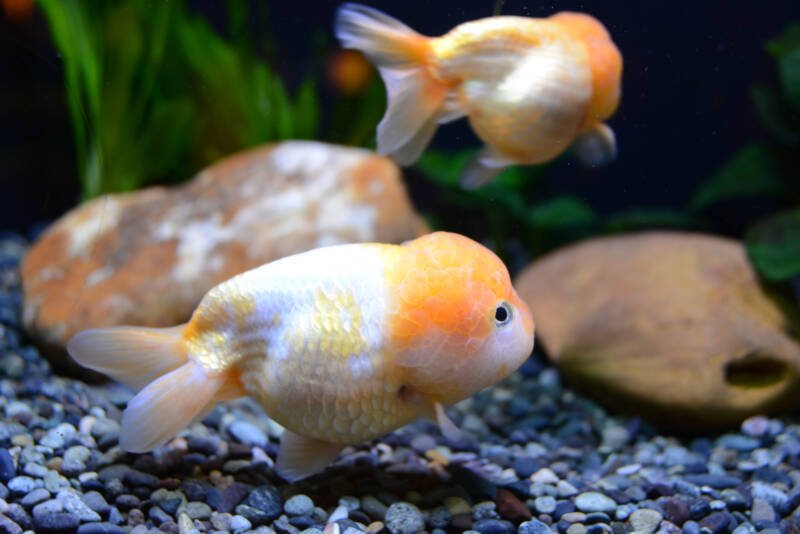
Many Ranchu enthusiasts start grooming their prize fish from an early age to achieve a prime hood.
Unlike a wen, the hood covers the top of the head, the gill cover, and the cheeks.
The hood starts to appear around three months, and it reaches maximum growth at about 4-5 years.
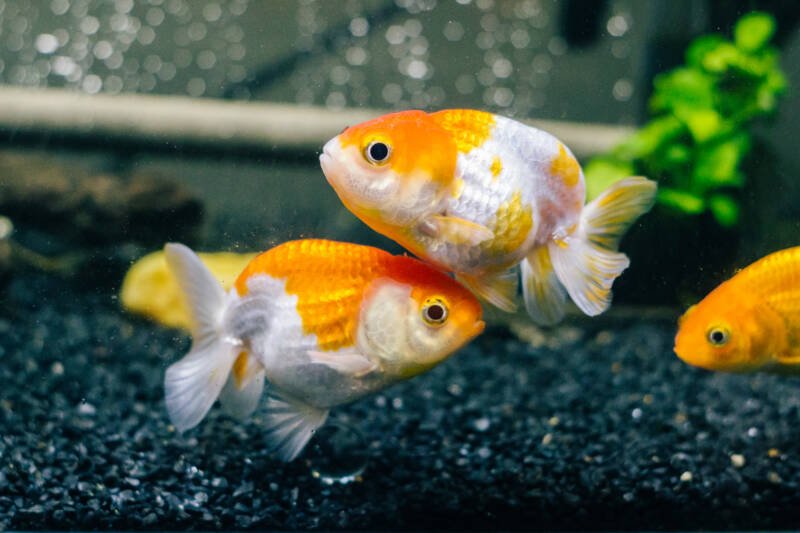
Grooming involves choosing the appropriate housing and diet. The goal? To produce a square head – similar to a buffalo – and a large, rounded body. This way, the Ranchu looks magnificent from above (for Japanese judges) AND from the side (for Chinese judges) – if you show them.
Space Planning
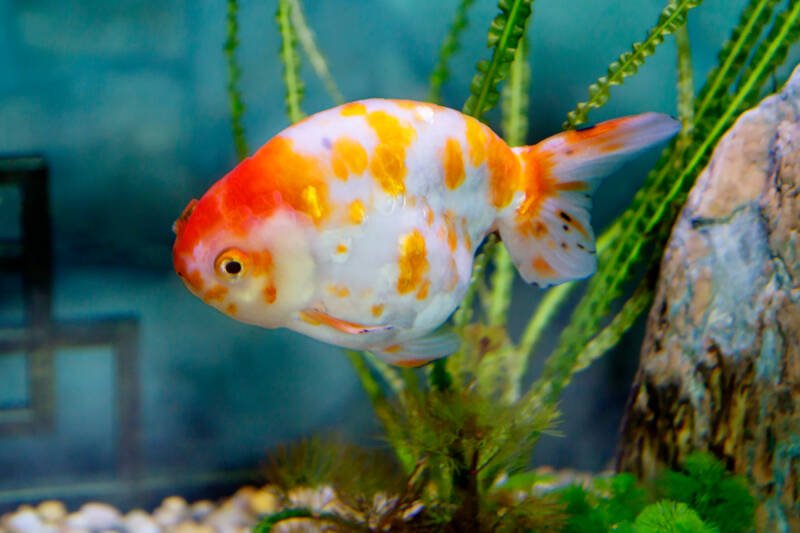
Most Ranchu goldfish reach eight inches (20 cm) in length. However, their size depends on the aquarium length.
Some aquarists have used a pond setting (which gets risky) and watched their Ranchus reach an impressive 18 inches (45 cm) long!
However, tank size isn’t the only determining factor on Ranchu size. Some fish have better genetics than others.
If you buy from a breeder that hasn’t taken care of their lines, you can provide plenty of space and still end up with a small goldfish.
Lifespan
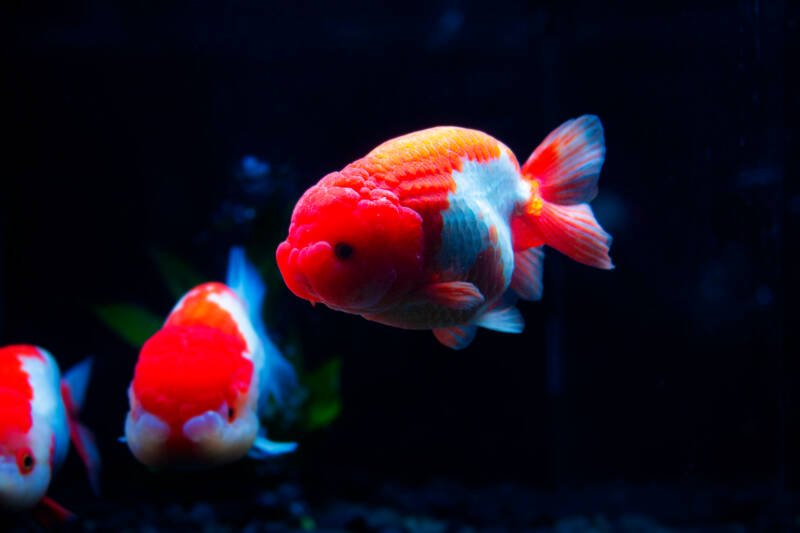
Once again, the quality of your Ranchu goldfish’s breeding plays a significant impact on their lifespan.
Those with excessive breeding in their lines may not live as long as other goldfish varieties – coming out around eight years.
But there are some Ranchus that have survived for ten, fifteen, and even TWENTY years.
It depends on how well their genetic pool has been cared for. And, of course, you’ll need to do your part by providing suitable housing and a quality diet.
Behavior
If Ranchu goldfish came equipped with a more streamlined profile and some genuine swimming speed, they might live up to their energetic personalities. But unhappily, they move with the speed of a lava lamp (and they’re about as colorful).
Sweet of temper, they swim with an enchanting “wiggle” that allows them to explore the tank – eventually.
You’ll have to hope whatever catches their interest also holds still long enough for them to reach it. Because while they’re unique and beautiful, champions athletes, they’re NOT.
And those egg-shaped bodies don’t do them any favors. You may see your Ranchus stop to rest on the bottom of the tank or even hanging motionless in the water column. They simply don’t have the pep to keep up with their interested minds.
You CAN get away with keeping a single Ranchu goldfish. But they prefer to stick with a few others for company.
It makes those slow-motion explorations more fun. They have a curious temperament, and you’ll enjoy it to the fullest with a school of at least three.
Tank Setup
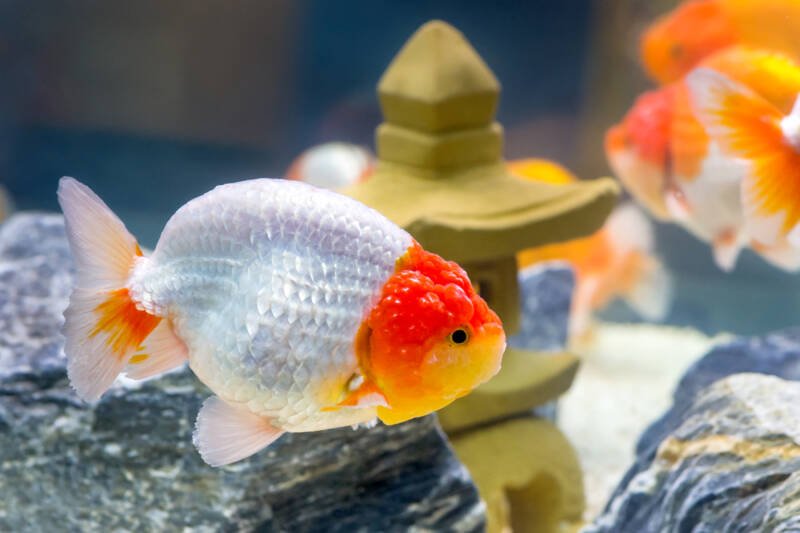
Ranchu goldfish don’t have the long, spreading tails of other goldfish breeds. This allows you to get away with housing them in a 20-gallon (80 l) tank – for one.
As you start to add more Ranchus, though, you’ll want to go up 10 gallons (40 l) for each additional fish.
Because they’re NOT the most agile swimmers, it’s best to focus on horizontal space rather than vertical. Ranchus WILL swim down and visit the bottom of the tank to forage, and you want to keep that trip as short as possible.
You’re also going to want to pick a top-notch filter. Ranchus are still goldfish, and they still produce a large amount of waste.
However, to limit the amount of water current produced, you may want to stick to a HOB filter. The gentle waterfall works best.
And when it comes to keeping Ranchu goldfish in ponds, you need to think things through. That IS how the Japanese originally designed the breed.
Similar to koi carp, you’re meant to view these fish from above and appreciate their round shape.
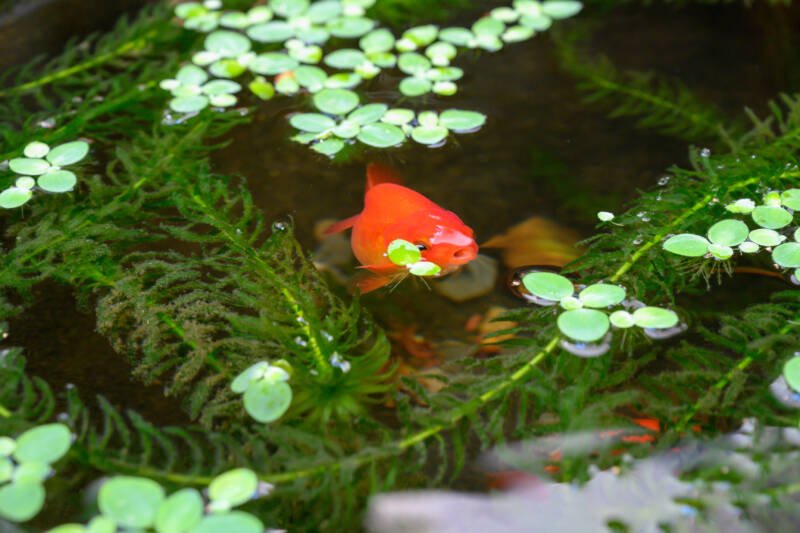
However, ponds are tricky. Often exposed to the outdoor elements, you COULD end up offering your (not precisely cheap) Ranchus up as easy snacks for predators. They’re slow fish, and they can’t reach safety in a hurry.
And ponds often end up subjected to extreme temperature changes.
You CAN keep them in ponds, but you’ll want to provide protective netting to avoid snacking by feral cats and other wildlife.
And if you live in an area that experiences seasonal changes, you may want to consider otherwise. Ranchu goldfish are simply too delicate.
Water Conditions
In general, goldfish breeds are hardy. They’ll tolerate a range of temperatures and water conditions. But Ranchus? Not so much.
They need their water to stay around room temperature: 65-72F (18-22C). They WON’T tolerate tropical conditions the way black moors do.
If things go too high or drop too low suddenly, they’ll die. They’re much too sensitive to cope with the change. This is why ponds aren’t ideal for most Ranchus. If you have a pond setup that remains stable, though, go for it.
They prefer a more neutral pH range, around 7.0-8.0. And when you’re attempting to breed them, you can go slightly acidic without causing any problems.
As for the water hardness, they’re flexible and will tolerate a range of 5-19dH.
While most varieties of goldfish can handle slightly “unclean” water conditions, Ranchu goldfish CAN’T.
You need your water to stay as pristine as possible. Otherwise, you may notice black patches developing as a result of ammonia poisoning.
Decorating the Ranchu Tank
Most of the time, when you have fancy goldfish, you need to take care with décor choices to keep unique traits safe.
For Ranchu goldfish, you need to consider your décor carefully – but it’s so you protect your fish from themselves.
Like other types of goldfish, Ranchus LOVE digging around in the substrate.
They’re usually looking for scraps of food they might have missed. And in their gluttony, they may swallow large pieces of gravel. This can lead to severe GI problems.
To prevent your Ranchu goldfish from creating obstructions in their stomach, try to avoid gravel or large-grained pebbles. Instead, use sand.
This will make the foraging process easier for your fish, and it’ll still give your aquarium (or even your pond) a clean look.
Of course, that may pose a problem for your live plants. But since Ranchu goldfish like to nibble plants, you already needed to make THOSE choices carefully, anyway.
You’ll want tough choices you DON’T need to worry about anchoring into the substrate.
Floating plants or hardy specimens, especially if they a bitter taste, will keep you from needing to restock the tank all the time. And some of the best options include:
Ranchu Goldfish in Communities
Ranchu goldfish have peaceful temperaments. This makes them ideal for incorporating into community aquariums – provided you choose the suitable tank mates.
They have specific needs you’ll need to meet to keep everyone safe and comfortable.
Tank Mates
Due to that SLOW swimming speed, you want to make sure you pick tank mates that won’t zip around and out-compete your Ranchus for all the food. You don’t want them to starve, after all.
And you need to consider tank temperature carefully. Too warm, and your Ranchus get stressed.
Some of the best tank mates for Ranchu goldfish include:
- Black moor goldfish
- Bubble-eye goldfish
- Chinese high-fin sharks
- Dojo loach
- Guppies
- Koi carp
- Lionhead goldfish
- Mosquitofish
- Pearlscale goldfish
- Platies
- Telescope goldfish
- Zebra danios.
Incompatible Species
If you’re considering a fish species known for aggression or speed, they won’t work with Ranchus.
Unable to mount any kind of defense (or escape), your Ranchus will end up bullied at best and starved at worst.
And if you have a tropical tank, the water temperatures will place too great a strain on the goldfish. They’ll succumb to illness.
The same is true if you pair them with most algae-eaters. These fish LOVE to snack on the slime coat of Ranchus, who can’t swim fast enough to escape.
So, in general, try to avoid these fish in your Ranchu community:
Food and Diet
Roly-poly Ranchu goldfish LIVE to eat. And since they’re omnivores, it isn’t a difficult undertaking.
The hard part comes with making sure they’re getting the food – and not simply gulping air at the surface.
Commercial sinking pellets serve as an ideal base for Ranchus. This keeps them from taking in too much air, leading to problems with their swim bladder.
Hikari Lionhead works excellent and provides the proper vitamins and minerals needed to keep those colors looking their best.
But you also want some protein in the mix. The CORRECT amount of protein, though.
If you go overboard, you’ll end up with fat Ranchus. And while you’d like them round, fat’s a different story. Popular protein sources include:
- Bloodworms
- Brine shrimp
- Tubifex worms.
And don’t forget the fruits and veggies! Blanching mandarin oranges, spinach, and zucchini will keep your Ranchus from developing GI issues.
Plus, you’ll help them retain those vibrant colors through natural boosts from the plants.
Breeding Ranchu Goldfish: “Seeing” is Believing
Some of the most impressive Ranchu goldfish have hoods that creep down over the eyes. It makes them look stunning, but it also obscures their vision.
And a male Ranchu that can’t see? Can’t reproduce. You’ll need to consider that when you start breeding.
A separate breeding tank is essential. And if that hood’s “in the way,” make sure you remove any décor from the equation. This way, the female can’t hide from the male. Otherwise, you’re never going to end up with Ranchu fry.
Males or Females?
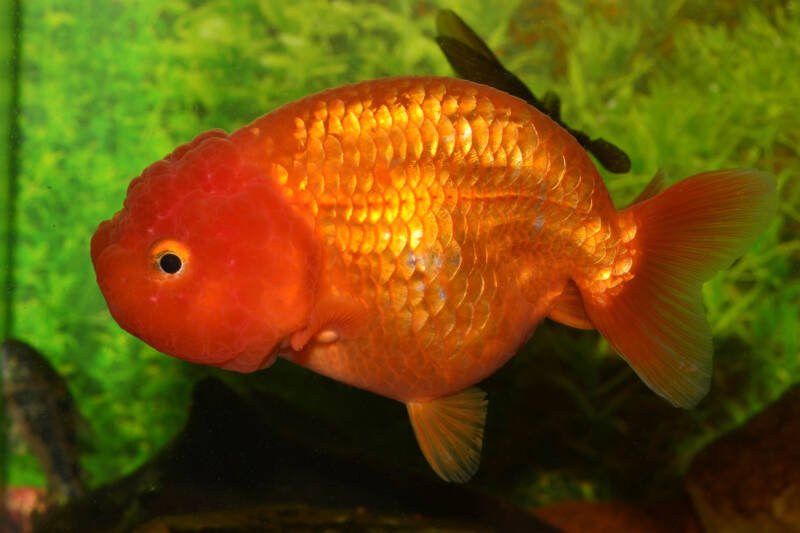
Due to the round shape Ranchu goldfish have, looking for a plump form to tell a female from a male won’t help you out.
Both sexes look the same, even when the female’s full of eggs. So you’ll need to do a little more detective work.
During spawning season, the male Ranchu develops breeding tubercles along the gill covers and face. These are small, white spots.
But you need to make sure the fish is sexually mature. Young males DON’T form the tubercles.
And, unfortunately, some females will have tubercles pop up. So you’ll want to watch for them AND check for behavior changes. Males ready to spawn start chasing females in circles around the tank. (You know, assuming they can SEE the female)
NOT Doting Parents
Ranchu goldfish scatter their eggs into patches of foliage. That makes it tricky if you needed to remove décor for a hooded male, but you can add a spawning mop into a corner for them to use.
The sticky eggs will cling to whatever they touch.
You MUST remove the parents once they finish spawning! Ranchu goldfish don’t exhibit any parenting skills. If you keep them in the breeding tank, they’ll eat the eggs.
So they need to go, or you need to transfer the plants (or mops) out of the tank.
The eggs hatch within 48-72 hours. The fry then hide out along the tank’s bottom while they absorb their yolk sac.
You can start feeding them with infusoria and green water. Within a few days after that, they’re ready for newborn brine shrimp.
Hardiness and Diseases
Depending on the breeder you obtained your Ranchu goldfish from, they may have good or bad genetic diversity.
Lower diversity means a HIGHER risk for common infections. This is why it’s essential to research your breeder ahead of time.
Ranchus kept in less than ideal conditions will quickly start to show signs of these common fish ailments:
You’ll want to isolate the ill fish and seek treatment right away. However, if you’ve done your homework AND kept the tank as clean as possible, this shouldn’t pose a problem.
A proper filter and regular water changes will go a long way toward preventing issues.
So will avoiding floating foods. Ranchus often have swim bladder issues due to their egg-shaped bodies.
When you compound it with too much gulped air, you’ll see them float at the surface. By using a high-quality diet composed of protein AND veggies, you’ll help.
Ranchu Goldfish: Are They For You?
Ranchu goldfish have earned the title “king of goldfish.” And you’ll see why when you price them.
The average is around $20-$30 – for a smaller fish. If you want to get a quality fish, you could pay up to $200. And a show Ranchu? That’ll set you back $1000 (at LEAST)!
This is why it’s essential to look for a healthy Ranchu from a quality breeder. And the odds are you won’t find one at the local chain store. (If you DO see one, it’s probably a lionhead goldfish that ended up mislabeled)
The best Ranchu doesn’t have a dorsal fin – or ANYTHING that resembles a dorsal fin.
You’ll want a rounded back with a pleasing arch going back from a broad, rounded head. And while it’s okay to see bubbling of the hood, it shouldn’t come down to cover the eyes.
The tail’s meant to be short and splayed to the sides of the body. It’s almost horizontal. It should droop down at a 45-degree angle from the caudal peduncle. And, of course, you want that egg-shaped body.
King of the Goldfish
Whether you want to try your hand at grooming Ranchu goldfish for show, or you simply covet the idea of owning the “king of goldfish,” you can’t go wrong with adding these plump beauties to your collection.
As long as you’re willing to keep that water pristine!
Do you have the “king of goldfish?” Have you tried grooming a Ranchu yet?
Do you maintain a tank, or have you set up a pond?
Let us know your stories and questions here!